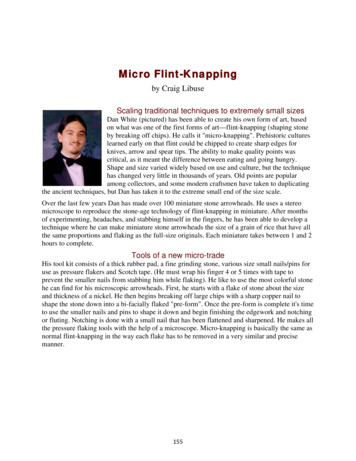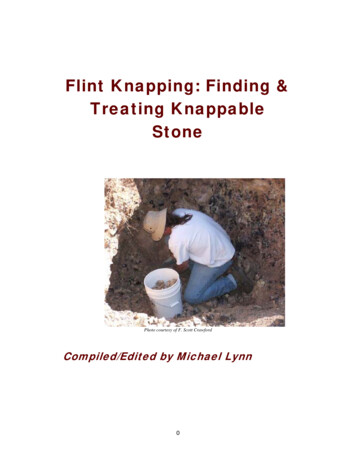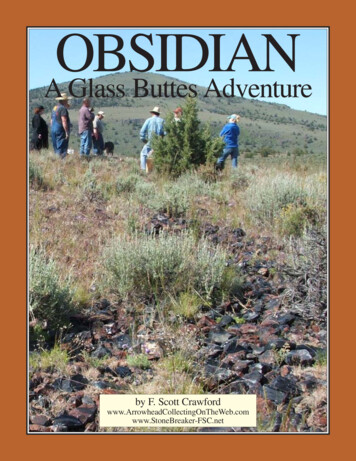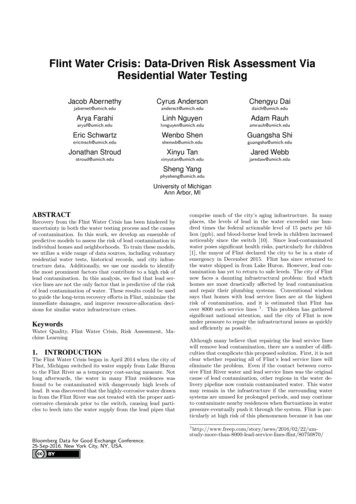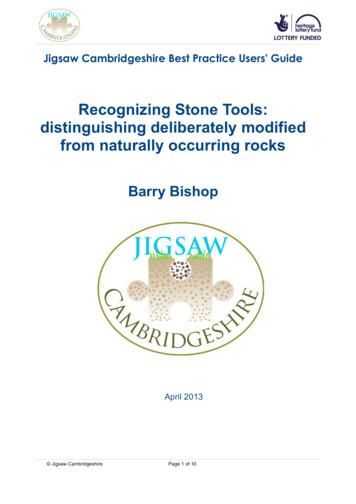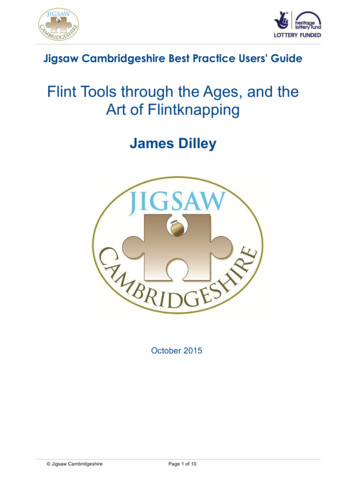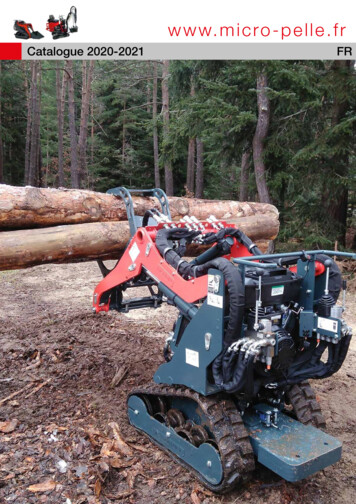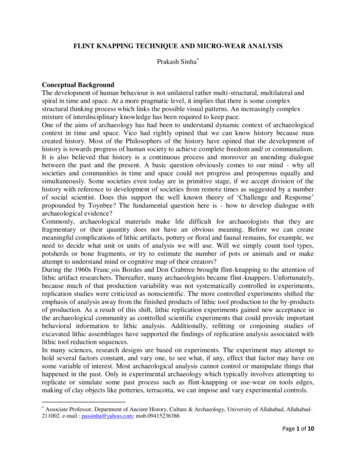
Transcription
FLINT KNAPPING TECHNIQUE AND MICRO-WEAR ANALYSISPrakash Sinha Conceptual BackgroundThe development of human behaviour is not unilateral rather multi-structural, multilateral andspiral in time and space. At a more pragmatic level, it implies that there is some complexstructural thinking process which links the possible visual patterns. An increasingly complexmixture of interdisciplinary knowledge has been required to keep pace.One of the aims of archaeology has had been to understand dynamic context of archaeologicalcontext in time and space. Vico had rightly opined that we can know history because mancreated history. Most of the Philosophers of the history have opined that the development ofhistory is towards progress of human society to achieve complete freedom and/ or communalism.It is also believed that history is a continuous process and moreover an unending dialoguebetween the past and the present. A basic question obviously comes to our mind - why allsocieties and communities in time and space could not progress and prosperous equally andsimultaneously. Some societies even today are in primitive stage, if we accept division of thehistory with reference to development of societies from remote times as suggested by a numberof social scientist. Does this support the well known theory of ‘Challenge and Response’propounded by Toynbee? The fundamental question here is - how to develop dialogue witharchaeological evidence?Commonly, archaeological materials make life difficult for archaeologists that they arefragmentary or their quantity does not have an obvious meaning. Before we can createmeaningful complications of lithic artifacts, pottery or floral and faunal remains, for example, weneed to decide what unit or units of analysis we will use. Will we simply count tool types,potsherds or bone fragments, or try to estimate the number of pots or animals and or makeattempt to understand mind or cognitive map of their creators?During the 1960s Franc ois Bordes and Don Crabtree brought flint-knapping to the attention oflithic artifact researchers. Thereafter, many archaeologists became flint-knappers. Unfortunately,because much of that production variability was not systematically controlled in experiments,replication studies were criticized as nonscientific. The more controlled experiments shifted theemphasis of analysis away from the finished products of lithic tool production to the by-productsof production. As a result of this shift, lithic replication experiments gained new acceptance inthe archaeological community as controlled scientific experiments that could provide importantbehavioral information to lithic analysis. Additionally, refitting or conjoining studies ofexcavated lithic assemblages have supported the findings of replication analysis associated withlithic tool reduction sequences.In many sciences, research designs are based on experiments. The experiment may attempt tohold several factors constant, and vary one, to see what, if any, effect that factor may have onsome variable of interest. Most archaeological analysis cannot control or manipulate things thathappened in the past. Only in experimental archaeology which typically involves attempting toreplicate or simulate some past process such as flint-knapping or use-wear on tools edges,making of clay objects like potteries, terracotta, we can impose and vary experimental controls. Associate Professor, Department of Ancient History, Culture & Archaeology, University of Allahabad, Allahabad211002. e-mail : passinha@yahoo.com; mob.09415236386Page 1 of 10
Above all a basic question is why man made tools? Indeed, until and unless we are able to knowthe function of the lithic tools it would be difficult to construct prehistoric economy andcognitive map of an archaeological period in the region. Micro-wear study can provide attributesto synthesize not only function of the tools but may also enlighten us on the instrument and gearsused to exploit material culture in the region during a particular archaeological period.There is always some meaning behind normal human action and to understand rationale behindhis/ her action one should understand the process of cultural constructs through contextualarchaeological evidence in time and space. This understanding may be accomplished throughexperimental archaeology.Typo-technological and metrical studies of ceramic and lithic industries especially in Indiancontext urgently require standardization. Single analyst cannot analyse all assemblages recoveredfrom different parts of India using one analytical design; and without comparing andunderstanding variability against standardized scale of typo-technological classification, wecannot, perhaps, formulate and reconstruct cultural past on scientific grounds.Flint Knapping Techniques:Longest period of human behavioral and cultural history has had been documented on lithics, themost abundant form of artifacts. Because of their physical properties they have withstood theinroads of environmental and human perturbation, such as erosion, decay, and landscapedevelopment and finally resulted into what archaeologist usually designate archaeologicallandscape. Moreover, they symbolize in many parts of the world the only form that signifiespresence of hominines and his activities. Obviously, lithic artifacts represent one of the mostimportant clues to understand prehistoric lifeways, behavioral development and cognitiveprocess that would have led to the development of cognitive ecosystem.A number of analytical procedures having different perspectives and approaches have beendeveloped and followed in different parts of the world to understand meaning behind prehistoriclithic artifacts. Mention may be made of typological procedure, technological procedure, typotechnological procedure functional procedure, chaine opratoire (operational chain), provenanceprocedure and statistical procedure. A holistic approach to these analytical procedures, indeedhas had been helpful to construct prehistoric society.It is important, perhaps, to conceptualize why man made tools, unlike his close cousins?Evolutionary advance, however, alienated men from other animals. Anatomically, man was builtneither to match the speed nor the strength of other animals. He did not possess even their sharpaggressive appendages and, therefore, had to depend entirely on his cunning for survival.The advantages the vertical body position provided and two well-developed forelimbs made itpossible for the ancient anthropoid apes to make use of such objects as stones, bones, etc, moreand more frequently in defending themselves from their terrible enemies, in hunting andsearching for food. As the digging have shown man’s primitive ancestors hunted small animalsand killed them with heavy objects, using stones to crack the shells of turtles and crabs. Thesystematic use of natural tools eventually caused man’s ancestors to try to adapt objects at handto their needs and, later, to fashion tools for various tasks, to approach conscious application ofgained skill. In the process of their conscious efforts, these men modified objects found in natureinto implements which served their needs. The fashioning of even most simple toolsdistinguishes man from the animal world, for no animal is capable of conscious activity, noanimal can fashion even the simplest tools.The transition from using tools found in nature (sticks/antler, jaws and stones) to the consciousfashioning of tools is the greatest leap in natural development and marks the transition fromPage 2 of 10
anthropoid ape to man. As a result of natural development, man’s ancestors acquired the abilityto work initially for food like other animals but more than animals for the defence. All hisefforts, in turn, influenced the development of man and his biological development as well.Generally, scholars believe that man made tools for hunting and got success because increasedcranial capacity or intelligence (Dart 1953; Washburn and Lancester 1968). If we analyse thesequestions keeping in perspective the differences in anatomy like brain, limbs, dentition, etc.between man and animals and variations in archaeological records in given time and space andthe vertical body position, then perhaps we may begin to work out some of these puzzlingproblems. Such issues have been discussed in detailed elsewhere and suggested that plausibly,his first need would have been means to defend himself and his children and that he madeartifacts on stone, firstly to protect and defend, and not for hunting (Sinha 1994, 1999, nd.).It is difficult to describe precisely how man started making lithic tools. Indeed, the ideaof making/flaking stone pieces might well have come to him due to interaction with theenvironment and learning through observation about happenings in the surround ings. Hemight have observed that when a stone boulder/block fell to the ground from a height itoften got broken when it landed on hard rock or another boulder. He might also haveobserved that when he threw a stone at an animal and his missile missed the mark and,instead, struck another hard material it often gets broken. When he looked at the chippedpieces he might have noticed that they usually have sharp lateral edges, which are goodto cut meat or plants. These are some of the possibilities which could have played aninstrumental role in giving man the idea of breaking stones to produce tools.Lithic technology, like other crafts, is a combination of two factors. The first is themethod, i.e. the use of the mind, and the second is technique, i.e. the use of the hand. Achange or variation in either or both usually causes variability in the assemblage(s) and or site.Experiments and ethno-archaeological data have demonstrated that there are primarilytwo techniques, percussion and pressure. But prior to getting down to making any tool orartifact, its morphological features and the technique that can be adopted to shape themmust be conceived in the mind, otherwise, one would not be able to make the desiredtool type or artifact. Thus, before making something, there is present in the mind, theshape of the tool and the technique to be adopted. Therefore, if one is making aparticular tool type it means that one wants to use the tool for some particular end.In the percussion technique either the object or the hammer is in motion; in the pressuretechnique neither is in motion. However, in archaeological literature a number oftechniques have been mentioned such as anvil technique, free hand-held technique,bipolar technique, inverse technique, clactonian technique, levalloisian technique,mousterian technique, grinding technique, fluted core technique, micro -bruin technique,flake-cleaver technique, etc. All these are innovations and improvisations on basic tooltechniques. Besides technique per se, other factors also play a significant role infabricating tools, such as the types of manufacturing tools, the raw material, and thedegree of skill with which the fabricator can coordinate hand, fingers, thumb and brain.Man had been perfecting his technology through experience, empirical knowledge.When he noticed that the stone hammer created deep scars because of pointed impact hechanged to antler / wood/bone hammers. With the help of such types of tools, commonlyknown as soft hammers in archaeological literature, he started getting diffused scars onthe flakes and fabricated tools which ultimately helped him to fabricate still finerartifacts with nearly straight working edges.Page 3 of 10
The percussion technique requires a fabricator or hammer which can impart sufficientforce to exceed the elastic limits of the stone and cause fracture. The application of thepercussion technique can be executed by both types of hammers, hard and soft. The hardor soft hammer controls the interval of contact. If the hammer is of antler, wood or bone(soft hammers) then the interval of contact is prolonged while with the stone hammer(hard hammer) it is shortened. Relatively, soft hammers contact a larger area than hardhammers. This causes the cone of force to have a larger truncation and the flakes to havea diffused bulb of percussion. Percussion technique can be of either the hard hammer orthe soft hammer type. All of the diverse variations of this technique will probably neverbe known, but it prevailed during the entire Stone Age until metal implements becamecommon. However, one of the most important variants of this technique is known as theindirect percussion technique or punch technique. In this technique, a punch is placed on awell-prepared platform of a core and the hammer imparts the force through a punch,hence indirectly. Because of this variant, the former percussion technique is usuallyreferred to as direct percussion technique. Indirect percussion technique is more accuratethan direct percussion and detaches straighter and more uniform flakes and blades withsmall platforms. The punch is a semi-pointed or blunt rod-like object of tenacious stone,bone, antler, horn, ivory or hard wood. For good results, two persons are required forworking the punch technique, one to hold the stone tool or core and the other to hold thepunch and deliver the blow. However, the maker can also hold the working objectbetween his feet leaving his hands free for holding the punch by one hand and give theblow by the other.In the pressure technique, blades/flakes can be removed from a core by using the chest orshoulder crutch or a staff held in both hands. The main feature which distinguished thepressure technique from the percussion and especially from the indirect percussiontechnique is that the hammer remained in direct contact with the stone core or flake andwas pressed hard till a narrow blade or flake was detached. Thus a constant forte for alonger duration was involved in this case in contrast to the swings of the hammer in thepercussion technique. Generally, pressure flakes/blades are small and thin as compared tothose made by percussion or indirect percussion techniques. For obvious reasons, thistechnique would have been used more in making tools through retouching and backingtechniques than in manufacturing blades/flakes.Besides these basic techniques, there are some specialized techniques or core preparationor pre-planned – visualizing final end product. Mention may be made of most commonspecialized techniques like Levalloisian, flake-cleaver, Mousterian, Fluted Core,Backing, micro-burin, etc.Primarily, lithic technology is a reductive process, unlike other prehistoric technologies such aspottery production or house construction. Stone is always removed to produce a tool and neveradded. Cores are also systematically reduced to produce usable blades or flakes. Lithictechnology, however, may be classified as a reductive process until composite tools or gears arenot made. The function of artifact may change as the artifact form is changed. The form, sizeand other technical attributes of lithic artifacts may change or modified because of a number offactors like heat treated objective stone, prolong use, abundance or scarcity of raw material closeto the site, reutilization, retouching, etc. Hence, the dynamics of stone tool morphology isessential for lithic analysts to understand.Page 4 of 10
Typo-technological ProcedureThe term ‘culture’ in archaeology has had been in currency with very restricted meaning unlikethe definition and or meaning usually understood in social sciences and humanities. Indeed, thereno one definition or meaning of ‘culture’ in social sciences and humanities. Archaeology mainlydeals with cultural material and on that basis archaeologists identify sites in time and space.Similarities and dissimilarities in assemblage (s) play a crucial role in constructingarchaeological time scale both in spatial (facets) and temporal dimensions (periodization). Tomeet this requirement archaeologist tagged assemblage of cultural material with some reasonablename, on its first discovery, primarily based on some special morphological features of culturalmaterial, including their medium and uses the word culture as suffix to the name. For example,sites or assemblages of Lower Palaeolithic culture, Upper Palaeolthic culture, Painted Grey WareCulture, Northern Black Polished Ware culture, etc. only denote similarities in morphologicalfeatures no more, no less. Similarities in the assemblages usually treated as belonging to similarperiod while dissimilarities may refer to spatial and / or temporal changes. Typologicalprocedures of classification of archaeological lithic assemblages are primarily based similarpresumptions.Shape, size, technique of manufacturing- hard / soft hammer, percussion/ pressure, direct/indirect percussion; nature of retouching, class of retouching, invasiveness of retouching,primary form of artifacts are some of the variables usually considered in analyzing lithicassemblages under typo-technological procedure.The Chaîne OpératoireThe chaîne opératoire or ‘operational chain’ or ‘sequence’ refers to the range of processes bywhich naturally occurring raw materials are selected, tested, transported, knapped and reducedinto a shaped tool and or transformed into usable cultural products. This procedure cancontribute to the reconstruction of the dynamic context of archaeological landscapes, bothnatural and social. This goal-oriented activity can be considered as a structured and generativeinterplay between mental and material possibilities, involving planning and decision-making aswell as more tacit or routine reactions (Keller and Keller 1996; Schlanger 1996).Provenance ProcedureA good understanding and identification of lithic raw material exploited by prehistoric man arenot only required to know factors that would have caused variability in shape and size ofprehistoric lithic artifacts and modification in methods and techniques of manufacturing artifactsbut also to know their source of location. Knowledge about source of raw material in the regionmay provide data on social and economic aspects such as catchment area, range of mobility,exchange network, etc. Although macroscopic techniques can be helpful for provenance studies,their precision is subject to greater degrees of error than geochemical techniques. However, sincemany of the rock types used for chipped stone tools have as much variation within a sourcelocation as between source locations, even geochemical techniques are subject to error.Geochemical techniques of stone analysis are used to determine the elemental composition oflithic artifacts. By matching the elemental composition of artifacts to raw material from varioussource areas the provenance of raw material used to make artifacts can be determined. Stone iscomposed of elements classified into one of three groups: (1) major elements (those that make up2% or more of the sample); (2) minor elements (from 2% to 0.1% of the sample); and (3) traceelements (those in concentrations less than 0.1%). Geochemical techniques frequently focus ontrace elements to determine provenance. There are several different techniques of geochemicalanalysis, mention may be made of – X-ray fluorescence spectrometry, Particle induced X-rayPage 5 of 10
emission analysis, Electron microprobe analysis, Instrumental neutron activation analysis,inductively coupled plasma emission spectroscopy and Atomic absorption spectroscopy.Micropalaeontology ApproachBesides geochemical techniques, micropalaeontology approach is being also followed to studysources of lithic. A rather different focus is taken in micropalaeontological approaches. Here theinterest shifts from constituent elements to fossils, most notably foraminifera in materials likeflint and chert. It is argued that consistent relationships can be identified between the presenceand relative frequency of fossil species, and the source of flint and chert.PetrographyOne of the more established approaches, petrography is the characterization of stone in terms ofits mineralogy and structure (Kempe and Harvey 1983). The technique involves removing asmall piece either by sawing a section or drilling a core. Though the former has a long history,the latter is increasingly common as it has less impact on artifacts that we are reluctant todamage for aesthetic or other reasons. The ends of a core can be used to plug the hole left bysampling.Petrography can characterize a range of raw materials, and has proved valuable in determiningthe distribution of tools, sculpture and building materials away from their geological sources(Olsen and Alsaker 1984). Whilst this technique has been successful on these materials, it is oflimited value with others, such as flint.Page 6 of 10
Page 7 of 10
Micro-wear Study:The aim of microwear studies is to reconstruct as completely as possible, the primary economicactivities and behavior of prehistoric groups. Following systematic procedure of microwearanalysis scholars have not only inferred the functions of lithic tools and thus least rather moreabout prehistoric economics.Microscopic study of wear pattern on humanly made artifacts is microwear analysis. These wearsmay be due to various factors such as alteration in the course of manufacturing artifacts,technical wears; alteration due to use, use-wear and alteration caused by natural agencies, naturalwears. Distinguishing them and identifying use-ware is the job of micro-wear analysts. It wouldbe, therefore, better to designate such microscopic study as micro-wear analysis instead ofgenerally used term, lithic use-wear analysis.After eliminating technical wear and natural wear features, a use-wear (functional) analysis isprimarily based on various microscopic features. Some of important features are the study of (i)Edge-wear pattern: (a) types of micro-scars, (b) location of micro-scars, (c) depth of micro-scars;(ii) Striation: (a) types of striations, (b) location of striations, (c) orientation of striations; (iii)Polish: (a) types of polish, (b) location of polish, (c) distribution of polish; (iv) Raw material ofartifacts; (v) Used edge angle of artifact; (vi) Morphological features of artifact.The study of lithic technology, indeed contributed a lot in understanding prehistoric lithicartifacts, but unless and until we know the function of these lithic tools it would be hard to revealdynamics of tools and the systematic context of the sites. Analytical procedures based onethnographic parallels, edge damage pattern, edge angle, kinetic movements of tools, high & lowpower microscopy, image processing technique, multi-dimensional approach and residueanalysis have contributed significantly in this direction.Ethnographic ParallelsThe development of the analysis of the function of stone tools began by the use of analogy withethnographic tools. The main problem, apart from assuming a direct correlation between formand function, is that many prehistoric tools have no ethnographic analogues, notably hand axesand burins.Edge Damage PatternGould, Koster and Sontz (1971) observed that the wear traces on Australian Aboriginal adzes(purpuna), used for planing hard wood, appeared similar to those on Quina scrapers, andtherefore inferred that the Quina scrapers were used on hard wood.Typologically, both concaveand convex scrapers are classed in the same group of tools, but they could not have been used inthe same way because the two kinds of edges are not mechanically useful for the same task.Edge AnalysisWilmsen (1968) measured 2,139 artifact edge angles and he claimed that the analysis showedthere to be 3 modes: 26-35 degrees, 46-55 degrees and 66-85 degrees. Wilmsen interprets theactivities that these edge angle modes represent as follows: 26-35 degree angled edges were usedfor cutting, 46-55 degree angled edges were used for hide scraping/heavy cutting and the 66-75degree angled edges were used for wood and bone working. White and Thomas then went on toderive a classification of the prehistoric material based on such attributes as edge angle. Thisprocedure constitutes one of first attempts to produce a functional classification.Kinetic MovementsAfter the translation of Semenov's Prehistoric Technology in 1964 the emphasis in use-wearanalysis centered on the use of microscopy for studying the effects of use on the edges of tools.Page 8 of 10
At first this was mainly concerned with low power (i.e. 100 magnifications) looking principallyat edge wear. Low power microscopy (up to 80x) was used mainly to ascertain how the edgeangle changed during use.In the paper by Tringham et al. (1974) experiments were carried out totest the following hypothesis: "A tool made of a specific raw material, whose edge is activated ina specific direction across a specific worked material will develop a distinctive pattern of edgedamage of a kind that is recognizable on the edges of prehistoric tools". Odell and Odell (Odelland Odell-Vereeken,1981) accepted that the technique is limited to identifying the hardness ofthe material rather than specific materials.Fracture AnalysisA major aspect of low power micro-wear analysis is the classification of fractures. Kamminga(1982) devised 6 types of fractures in his classification scheme.High PowerHigh power microwear analysis was developed by Keeley from Semenov's work (1964). Highpower microscopy involves using magnifications of 100 plus, normally characterising use-weartraces at 200 magnifications, but occasionally using up to 400 magnifications. The extrainformation gained through the use of higher magnifications centers on polishes of workedmaterial. Keeley carried out a series of experiments using various tools and he claims to haverecognized that specific materials produce distinctive polishes, so that we have bone polish,wood polish, hide polish, etc.Keeley originally stated that these polishes are distinctive when certain variables are controlled,in particular the raw material of the tools, so that a prerequisite of any microwear study is anexperimental programme using simulation experiments with similar stone, preferably from thesame source as that of the archaeological material. The main problem with high powermicrowear analysis is that the descriptions of the distinctive polishes are subjective and largelyunusable by independent workers.Image Processing TechniquesThe quantification of microwear polishes would facilitate their classification by mathematicalcriteria, rather than by individual expertise, and any microwear analysis so classified would becomparable with any other. This quantification has been carried out with the use of imageprocessing techniques like Confocal Laser Scanning Microscope (CLSM), Laer InducedBreakdown Spectroscopy (LIBS), UBM (Ulrich Breitmeier Messtechnik) Laser Profilometry,etc.Multi-Dimensional ApproachIn response to the fundamental doubts that have been raised about the accuracy and usefulness ofmicrowear analysis as it is currently practiced, a new approach, multi-dimensional approachwhich attempts to standardise the methodology of microwear analysis and to test the limits of itsinterpretations has been used. These include the morphology of the working edges, utilizationdamage, the orientation of striations and the location and extent of micro-wearpolishes.Correlations between the variables then allow the analyst to eliminate some of thepossible functions of a tool until the most probable function is isolated.Residue AnalysisFor the last one decade, some scholars are working hard to infer function of stone tools on thebasis of extraction and identification of organic materials from the edges of stone tools.But suchstudies only limited to infer probable worked material.To infer kinetic movements / activitiescarried out by archaeological tools, edge damage pattern, direction and nature of striations arerequired variables /attributes and that can be obtained by high power microscopy.Moreover, onePage 9 of 10
should take all precautions and care while inferring the function of tools on the basis of organicresidues alone for obvious reasons.Micro-Wear and Phytolith Analysis: A new sets of experimentsHigh power microscopy is primarily based on experimental catalogue of worked material.Analysis of phytoliths from archaeological soil samples of concerned site may give clue forvegetal material present and or exploited by inhabitants. Hence experimental catalogue may bedeveloped accordingly.Mould-Replication ProcedureThis procedure is being developed. However, it was initiated by Straus and Walker in the year1978. If developed successfully, it will not only an economical procedure for micro-wearanalysis as micro-traces could be observed under normal binocular and / or stereo microscopesbut will also open the scope of comparative study among analysts.Applications of Micro-wear Analysis The variability between assemblages in terms of activities that took place at the sites,then edge analysis can group the tools into types having similar functional capabilities. That is, groups of tools are held to be associated with a particular activity, but withoutnecessarily specifying exactly what that activity is. Therefore, one can construct a functional typology that can be quantitatively comparedwith other assemblages in order to ascertain the similarities or differences in activitiesrepresented at different sites. Another way in which use-wear analysis can be used on whole assemblages is to attemptto interpret the function of a site as a whole, in terms of the range of activities that werecarried out at the site. Knowing the range of activities would help to interpret the function of the site as a homebase, kill site, hunting station, specialist activity site (such as a hide processing site) etc The kind of analytical process described above could be applied to an assemblage inorder to interpret the subsistence strategy associated with a particular site. The separation of the tools i
During the 1960s Franc ois Bordes and Don Crabtree brought flint-knapping to the attention of lithic artifact researchers. Thereafter, many archaeologists became flint-knappers. Unfortunately, because much of that production variability was not systematically controlled in experiments, replication studies were criticized as nonscientific.
